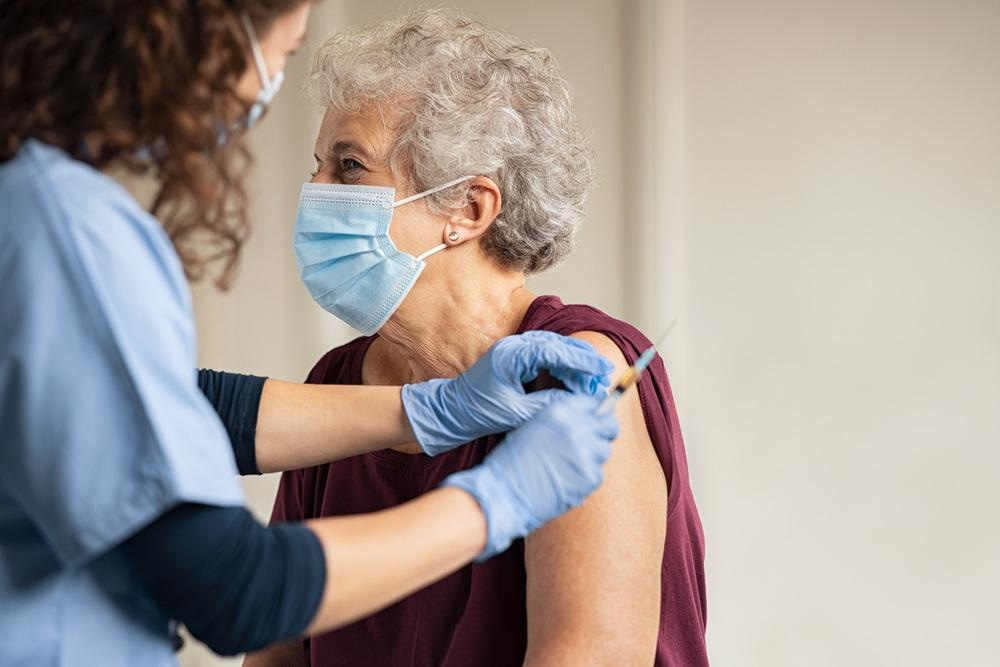An exciting study could revolutionize vaccinations with a novel painless method utilizing fast-dissolving microneedles (MNs). This research has been published as a pre-proof in the International Journal of Pharmaceutics.

Study: A Dual-Delivery Platform for Vaccination using Antigen-loaded Nanoparticles in Dissolving Microneedles. Image Credit: Rido/Shutterstock.com
The Requirement for a Painless Vaccination Alternative
Intermuscular administration for most vaccines is the conventional method used for infectious diseases such as influenza, hepatitis B and most recently, the SARS-CoV-2 (COVID-19) vaccine. While this administration method is used widely, adverse side effects such as pain and soreness from using a hypodermic needle can cause resistance in patients undergoing vaccination.
However, using an alternative vaccination method like transdermal administration, which includes applying medication or a drug through the skin such as through an adhesive patch, can be seen as more desirable. This pain-free administration route can be promising for vaccine delivery due to its ease of use and the accessibility to immune cells rampant in the skin.
Transdermal vaccines have already been established in literature, with previous research being developed and tested in animals against multiple infectious diseases including diphtheria toxoid, anthrax, hepatitis B, and influenza.
However, to transport large drug molecules or proteins across the skin's stratum corneum barrier, researchers have utilized microneedles, laser ablation, and iontophoresis. This has proven to be effective, with examples comprising the delivery of drug-loaded PLGA nanoparticles through the skin via iontophoresis.
Still, these other methods can be seen as expensive and inefficient. Microneedles are a more desirable approach for vaccine delivery, that include creating temporary micron-sized pores in the skin using an array of MNs that allow the crossing of the skin barrier for large-sized drugs.
Microneedles form microchannels that do not reach nerve-endings than hypodermic needles, ensuring less pain is felt during a vaccine delivery.
Microneedles
Microneedles can be categorized as solid, coated, hollow, or dissolving, and this particular novel research has focused on dissolving MNs for antigen delivery through the skin.
This innovative approach of using dissolving microneedles consists of 50 and 900 um in height, allowing the stratum corneum to be breached and enabling penetration into the epidermal skin layer, where they dissolve and unload the vaccine.
The advantages of this approach include reduced damage from a lower mechanical force used when applying the transdermal patch, as well as reducing sharps waste which is usually high in the currently ubiquitous hypodermal needle method. Additionally, patients can self-administer the treatment themselves, which reduces the inconvenience of booking and finding availability, while also reducing the requirement for healthcare personnel whose job it is to administer vaccinations.
Innovative Research
The innovative research team developed fast-dissolving MNs to deliver antigen-loaded polymeric nanoparticles (NPs) with a sustained release, aiming to achieve a dual-delivery platform for transdermal vaccination. They used microneedles that dissolve after penetrating the epidermal layer of the skin and release the NPs loaded with antigens for the infection.
Seven dissolving microneedle formulations were tested through various biodegradable polymers and sugars being analyzed with F7, a low molecular weight sodium hyaluronate, and trehalose dihydrate being considered optimal for producing uniform microneedle arrays.
The main dMN formulation was chosen by having an optimal mechanical strength and being efficient in microneedle dissolution, such as dissolving after 5 minutes. This formulation was loaded with poly(lactic-co-glycolic) acid (PLGA) NPs comprising a model influenza matrix 2 (M2) protein antigen.
The level of antigen-loading was investigated through centrifugation of various concentrations of antigen nanoparticles within the optimal microneedle formulation. Additionally, ex vivo mechanical strength and level of dissolvability were also assessed utilizing the optimal formulation consisting of M2 PLGA NP-loaded dMN and testing two different microneedle arrays on murine and porcine skin.
With further studies on this lead microneedle array and the pore formation in vivo, fluorescent dye NPs were used, and pore closure analyses have illustrated the temporary micropores from the microneedles closed soon after removing the patch.
The Benefits of Future Commercialization
Ultimately, this research illustrated a novel and innovative approach to provide an alternative to hypodermal needles as well as the conventional method of administering vaccines.
This transdermal vaccine concept has proven to be easy to formulate and effective in delivering antigens in a pain-reduced manner by utilizing nanoparticle-loaded dissolved microneedles that could revolutionize vaccine administration.
The promising nature of this research can be universalized for higher vaccination rates in less economically developed countries due to their reduced accessibility to vaccines and the trauma associated with needles and sterility.
Higher vaccinations for all infectious diseases including COVID-19 with self-administration can reduce the level of contact between possibly infectious individuals and reduce transmissibility.
Continue reading: How Polymer Nanoparticles Could Slow the Spread of COVID-19
Reference
Gomes, K., D'Souza, B., Vijayanand, S., Menon, I. and D'Souza, M., (2021) A Dual-Delivery Platform for Vaccination using Antigen-loaded Nanoparticles in Dissolving Microneedles. International Journal of Pharmaceutics, p.121393. Available at: https://www.sciencedirect.com/science/article/pii/S0378517321011996?via%3Dihub
Further Reading
Valdivia-Olivares, R., Rodriguez-Fernandez, M., Álvarez-Figueroa, M., Kalergis, A. and González-Aramundiz, J., (2021) The Importance of Nanocarrier Design and Composition for an Efficient Nanoparticle-Mediated Transdermal Vaccination. Vaccines, 9(12), p.1420. Available at: https://www.mdpi.com/2076-393X/9/12/1420
Disclaimer: The views expressed here are those of the author expressed in their private capacity and do not necessarily represent the views of AZoM.com Limited T/A AZoNetwork the owner and operator of this website. This disclaimer forms part of the Terms and conditions of use of this website.